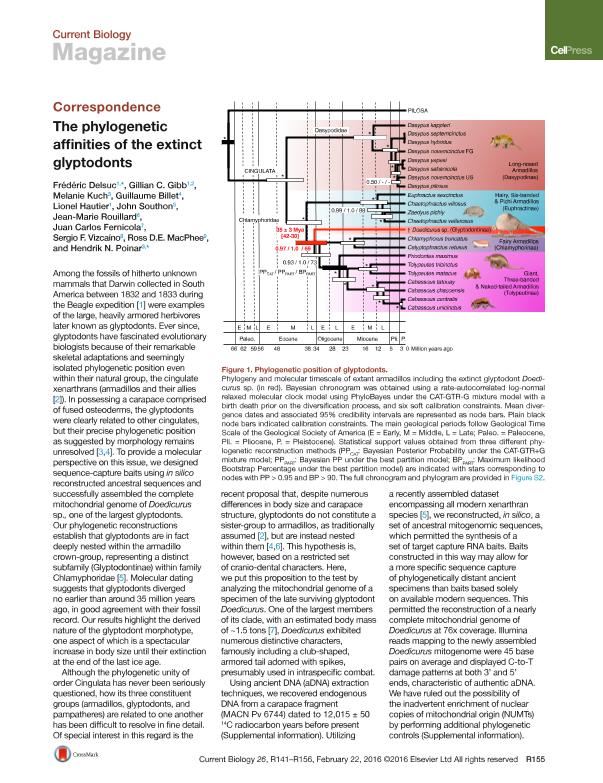Mostrar el registro sencillo del ítem
dc.contributor.author
Delsuc, Frédéric
dc.contributor.author
Gibb, Gillian C.
dc.contributor.author
Kuch, Melanie
dc.contributor.author
Billet, Guillaume
dc.contributor.author
Hautier, Lionel
dc.contributor.author
Southon, John
dc.contributor.author
Rouillard, JJean Marie
dc.contributor.author
Fernicola, Juan Carlos

dc.contributor.author
Vizcaíno, Sergio Fabián

dc.contributor.author
MacPhee, Ross D.E.
dc.contributor.author
Poinar, Hendrik N.
dc.date.available
2018-06-21T17:54:06Z
dc.date.issued
2016-02
dc.identifier.citation
Delsuc, Frédéric; Gibb, Gillian C.; Kuch, Melanie; Billet, Guillaume; Hautier, Lionel; et al.; The phylogenetic affinities of the extinct glyptodonts; Cell Press; Current Biology; 26; 4; 2-2016; R155-R156
dc.identifier.issn
0960-9822
dc.identifier.uri
http://hdl.handle.net/11336/49579
dc.description.abstract
Among the fossils of hitherto unknown mammals that Darwin collected in South America between 1832 and 1833 during the Beagle expedition [1] were examples of the large, heavily armored herbivores later known as glyptodonts. Ever since, glyptodonts have fascinated evolutionary biologists because of their remarkable skeletal adaptations and seemingly isolated phylogenetic position even within their natural group, the cingulate xenarthrans (armadillos and their allies [2]). In possessing a carapace comprised of fused osteoderms, the glyptodonts were clearly related to other cingulates, but their precise phylogenetic position as suggested by morphology remains unresolved [3,4]. To provide a molecular perspective on this issue, we designed sequence-capture baits using in silico reconstructed ancestral sequences and successfully assembled the complete mitochondrial genome of Doedicurus sp., one of the largest glyptodonts. Our phylogenetic reconstructions establish that glyptodonts are in fact deeply nested within the armadillo crown-group, representing a distinct subfamily (Glyptodontinae) within family Chlamyphoridae [5]. Molecular dating suggests that glyptodonts diverged no earlier than around 35 million years ago, in good agreement with their fossil record. Our results highlight the derived nature of the glyptodont morphotype, one aspect of which is a spectacular increase in body size until their extinction at the end of the last ice age.
dc.format
application/pdf
dc.language.iso
eng
dc.publisher
Cell Press

dc.rights
info:eu-repo/semantics/openAccess
dc.rights.uri
https://creativecommons.org/licenses/by-nc-sa/2.5/ar/
dc.subject
Phylogeny
dc.subject
Molecular
dc.subject
Glyptodonts
dc.subject
Doedicurus
dc.subject.classification
Meteorología y Ciencias Atmosféricas

dc.subject.classification
Ciencias de la Tierra y relacionadas con el Medio Ambiente

dc.subject.classification
CIENCIAS NATURALES Y EXACTAS

dc.title
The phylogenetic affinities of the extinct glyptodonts
dc.type
info:eu-repo/semantics/article
dc.type
info:ar-repo/semantics/artículo
dc.type
info:eu-repo/semantics/publishedVersion
dc.date.updated
2018-05-24T19:01:49Z
dc.identifier.eissn
1879-0445
dc.journal.volume
26
dc.journal.number
4
dc.journal.pagination
R155-R156
dc.journal.pais
Estados Unidos

dc.description.fil
Fil: Delsuc, Frédéric. Université de Montpellier; Francia
dc.description.fil
Fil: Gibb, Gillian C.. Université de Montpellier; Francia. Massey University; Nueva Zelanda
dc.description.fil
Fil: Kuch, Melanie. McMaster University; Canadá
dc.description.fil
Fil: Billet, Guillaume. Université Paris. Muséum National d’Histoire naturelle; Francia
dc.description.fil
Fil: Hautier, Lionel. Université de Montpellier; Francia
dc.description.fil
Fil: Southon, John. University of California; Estados Unidos
dc.description.fil
Fil: Rouillard, JJean Marie. University of Michigan; Estados Unidos
dc.description.fil
Fil: Fernicola, Juan Carlos. Consejo Nacional de Investigaciones Científicas y Técnicas. Oficina de Coordinación Administrativa Parque Centenario. Museo Argentino de Ciencias Naturales ; Argentina
dc.description.fil
Fil: Vizcaíno, Sergio Fabián. Universidad Nacional de La Plata. Facultad de Ciencias Naturales y Museo. División Paleontología Vertebrados; Argentina. Consejo Nacional de Investigaciones Científicas y Técnicas; Argentina
dc.description.fil
Fil: MacPhee, Ross D.E.. American Museum Of Natural History. New York; Estados Unidos
dc.description.fil
Fil: Poinar, Hendrik N.. McMaster University; Canadá
dc.journal.title
Current Biology

dc.relation.alternativeid
info:eu-repo/semantics/altIdentifier/url/https://www.sciencedirect.com/science/article/pii/S0960982216001214
dc.relation.alternativeid
info:eu-repo/semantics/altIdentifier/doi/https://dx.doi.org/10.1016/j.cub.2016.01.039
Archivos asociados
